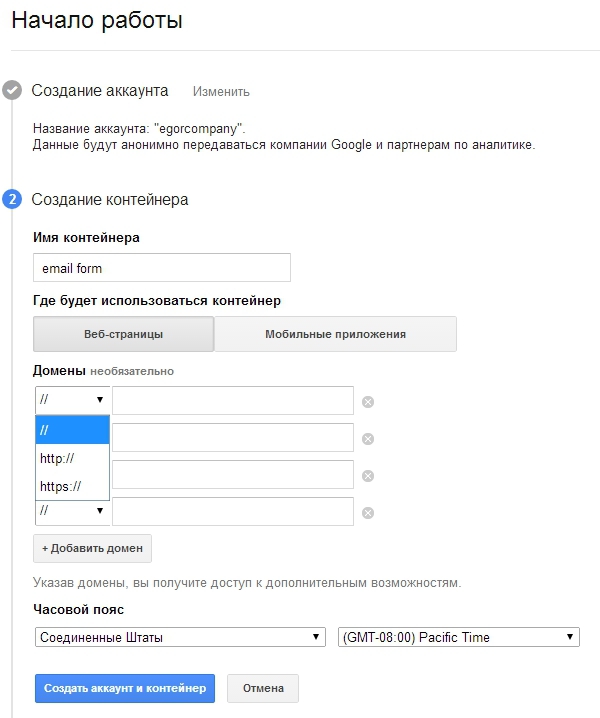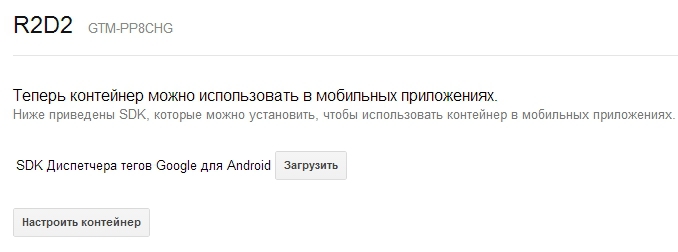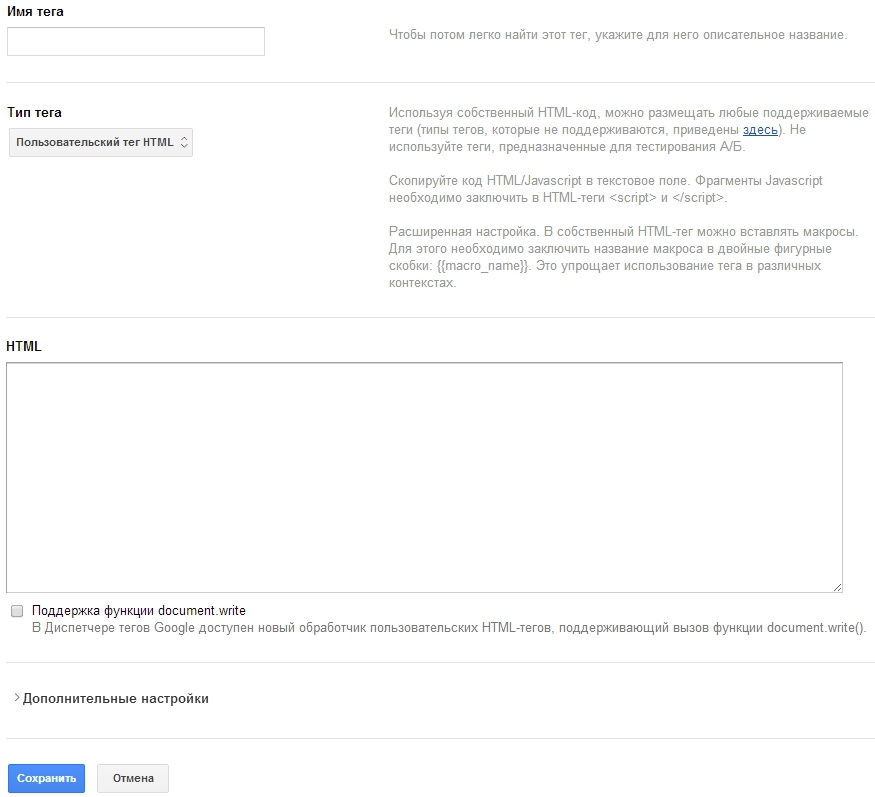Ale, Dispatch: AdvertOne vs Google Tag Manager

In one of the previous posts, readers drew attention to the similarity of the AdvertOne idea - embedding and managing the code of various ad networks “in one window” - and the Google Tag Manager, including, for example, managing the advertising code. The comparison suggested itself, so we decided to sort out the Google Tag Manager in more detail, to see if it leaves room for Adverton under the sun?
▌ Google Tag Manager
Goggle Tag Manager (Google Tag Manager) is one of the services of the “corporation of good” that allows you to embed almost any HTML / Javascript code into a special container, and manage it remotely, through the personal account of the Tag Manager, without having to enter the site code in the future . Practically necessary solution for those sites that use many third-party year pages (counters, forms, tracking programs, etc.)
Using the GTM container allows you to unify the management of tags (third-party code). You do not need to call a programmer if you want to add a new counter to the site - just change the contents of the container in GTM, add a new tag and everything integrates automatically. Google Tag Manager supports almost any system that requires you to embed your code on the site.
')
Using
If you have a google account, then no additional registration is required: to get started, just go to www.google.com/tagmanager and click "Sign in to your account".
After logging in to Google Tag Manager, the system prompts the user to create an account and start creating a container in which the code will be placed:

At the same time, it is necessary to choose the name and the platform on which the code will be executed: a web page or a mobile OS (GTM can be used on iOS and Android). The domain at this stage, if you chose web hosting, is optional.
After this, Google will offer you to take a short user agreement, most of which is devoted to the fact that the company is not responsible for how you will use third party data using GTM, by accepting which you will finally receive the container code "Tag Manager." When choosing a mobile OS, the GTM container will be provided to you in the form of an archived SDK.

The resulting container code must be placed at the beginning of the page after the opening tag. If you are not friends with HTML markup, then this is the only action for which you need a programmer. Then you can manage the code placed in this container yourself, directly from your GTM account.
Having placed the container code, you can proceed to setting it up - that is, actually loading the tags (the code that will be executed in this container on the site).
Firstly, Google supports by default a number of own and friendly services, the code of which it offers to embed in just a couple of clicks: Google Adwords, Google Analytics (with support for ComScore and ClickTale), DoubleClick Floodlight, AdRoll, AdAdvisor, etc.

Secondly, and most importantly, GTM allows you to use your own code. This can be either an image code (for example, if you use an invisible single-pixel image for tracking), or any other HTML or javascript code: counters, ad networks, social buttons, email subscription forms, feedback forms, etc. d.

Several different tags can be contained in one container at once - Google Analytics and Yandex.Metrica can be launched simultaneously on different pages of the same site.
The exceptions that GTM does not support are:
Tags with synchronous loading.
- Some tags containing code snippets placed in the header or footer of the page. Although you can use event-based rules in gtm.load to activate some of them (see documentation for developers), for tags consisting of two parts, synchronous loading is usually required.
- Tags related to the internal structure of the page - for example, social networking widgets and tags for displaying ads.
In the advanced settings of the tag, you can set the rules for its activation.
The rule is a condition under which the execution of the code will be launched or blocked. For example, you can set the launch of a tag on certain pages, or activate it by user actions (for example, by going to a specific url). For example, an ad unit code (AdSence) and a counter code (Analytics) have been added to the GTM container. In GTM manager there is a condition that the AdSence tag is activated only if the URL starts with example.com/about. As a result, we will receive a counter code on all pages and only on pages about the ad unit.
In the future, the rules can be changed without having to go into the site code (or with minimal need, if a more complex macro is installed - for example, {{event}}). Macros are conditions for creating rules. GTM already has a set of ready-made macros, which will be sufficient for most users.
All manipulations performed in the “control room” do not affect the code posted on the website or in the application until the user clicks the “Publish” button. Only after that the contents of the container will be updated.
In this case, for different versions of the site (or mobile application), you can use different code tags - for example, for the second version of the site add another counter tracking user behavior. This can be useful in case of a conflict between the code of the old version of the site and the new one.
In mobile applications, the use of GTM allows you to update the same meter codes directly - without the need to download an application update to the market.
▌ Advertone
Adverton is a more specialized tool. Unlike Google Tag Manager, which works with virtually any code, AdvertOne is designed to host and manage the code of ad networks. Through Adverton's control panel, the user can customize the appearance, special visual effects, location, frequency of ad block displays, rotation of various ad networks, as well as track placement results. Individual platforms are available for individual support with full support for setting up and maintaining the service.
Statistics
The key advantages of AdvertOne are detailed statistics and ad testing capabilities.
Statistics "Advertona" allows you to track all the important information on the spin-off advertising: the number of impressions, clicks, to calculate the conversion. The presence of statistics and the ability to unscrew the codes of different advertising networks in one container at the same time opens the second possibility: testing.
The use of containers allows the implementation of a / b testing of the placed elements without programming special functionality and deep knowledge in this area. Rotation of ads within the same ad unit allows for a / b testing of ads as accurately as possible. The user only needs to verify the statistics obtained in Adverton with earnings in each network and choose the most profitable.
In Google Tag Manager, a / b testing functionality in GTM is only in the plans so far - however, when it is launched, theoretically, anything can be placed and tested in it - for example, the effectiveness of subscription forms. Generally, it is for unscrewing ads, and not tracking user behavior, Tag Manager fits rather poorly: you cannot display ad networks through the GTM container — you need to write a special java script to display ads in the right place on the site. Otherwise, if you just insert the code, it will be executed in an invisible place on the page and the site visitor will not be noticeable.
In the meantime, Adverton’s plans include ad targeting settings, even more detailed statistics and integration with advertising network accounts. Also in Advertone there will appear analogues of the GTM rules - by placing the pass-through code of the AdvertOne container, the user will be able to set a spin on different pages of the site of various ad networks.
▌ Summary
Conceptually, both services are united by the fact that they allow site owners to reduce the need for programmer services. This is important for small projects and for giants. The more the staff of programmers, the more time can take such a primitive operation as replacing the counter code or advertising twist. Where better to direct it to more productive work.
However, the difference between projects is much more significant. Google Tag Manager is a universal combine that simplifies the management of embedded codes, even with a staff of programmers, but it is practically not suitable for unscrewing ads.
 any embed code
any embed code version control system that allows you to insert different code for different versions of programs
version control system that allows you to insert different code for different versions of programs asynchronous code
asynchronous code lack of statistics
lack of statistics no rotation
no rotation lack of support for advertising modules out of the box
lack of support for advertising modules out of the boxplans: a / b testing
AdvertOne is a narrow, and therefore more suitable for advertising, tool.
 statistics
statistics the ability to rotate ads in one window
the ability to rotate ads in one window highly specialized
highly specializedplans: targeting, integration with advertising networks, detailed statistics, rules.
So, choosing one thing will not work out - the systems are too different, and therefore, on the contrary, they are excellent for sharing - AdvertOne for unscrewing ads, and GTM - for everything else. Try it yourself:
advertone.ru
www.google.com/tagmanager
▌ PS And so as not to get up two times: in the comments we were also interested in comparing Adverton with OpenX.
OpenX is an open source advertising server that includes ad placement management functionality, a system for tracking user behavior and collecting statistics. Since 2011, the direct download of OpenX is closed. According to the official version, this decision was made as a result of numerous attempts to break the system code. Now there are two options for OpenX - paid Enterprise and OpenX PHPAds in the form of PHP scripts, which can be downloaded and installed on your server for free.
Ideologically, this project is the exact opposite of AdvertOne and Google Tag Manager - this is not a SaaS solution, but a complex out-of-the-box software that requires complex configuration and programming skills. Thanks to the open code, if you have certain knowledge in the system, you can make the necessary changes. When developing AdvertOne, we studied and used OpenX, and its complexity for the average user was one of the reasons why we did our project in some way.
Source: https://habr.com/ru/post/218139/
All Articles